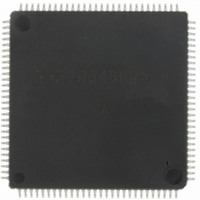DF70845AD80FPV Renesas Electronics America, DF70845AD80FPV Datasheet - Page 433

DF70845AD80FPV
Manufacturer Part Number
DF70845AD80FPV
Description
IC SUPERH MCU FLASH 112LQFP
Manufacturer
Renesas Electronics America
Series
SuperH® SH7080r
Datasheet
1.DF70844AD80FPV.pdf
(1644 pages)
Specifications of DF70845AD80FPV
Core Size
32-Bit
Program Memory Size
512KB (512K x 8)
Core Processor
SH-2
Speed
80MHz
Connectivity
EBI/EMI, FIFO, I²C, SCI, SSU
Peripherals
DMA, POR, PWM, WDT
Number Of I /o
76
Program Memory Type
FLASH
Ram Size
32K x 8
Voltage - Supply (vcc/vdd)
3 V ~ 5.5 V
Data Converters
A/D 8x10b
Oscillator Type
Internal
Operating Temperature
-40°C ~ 85°C
Package / Case
112-LQFP
No. Of I/o's
76
Ram Memory Size
32KB
Cpu Speed
80MHz
Digital Ic Case Style
LQFP
Supply Voltage Range
3V To 3.6V, 4.5V To 5.5V
Embedded Interface Type
I2C, SCI
Rohs Compliant
Yes
Lead Free Status / RoHS Status
Lead free / RoHS Compliant
For Use With
R0K570865S001BE - KIT STARTER FOR SH7086R0K570865S000BE - KIT STARTER FOR SH7086HS0005KCU11H - EMULATOR E10A-USB H8S(X),SH2(A)
Eeprom Size
-
Lead Free Status / RoHS Status
Lead free / RoHS Compliant, Lead free / RoHS Compliant
Available stocks
Company
Part Number
Manufacturer
Quantity
Price
Company:
Part Number:
DF70845AD80FPV
Manufacturer:
TAIYO
Quantity:
40 000
Company:
Part Number:
DF70845AD80FPV
Manufacturer:
Renesas Electronics America
Quantity:
10 000
- Current page: 433 of 1644
- Download datasheet (10Mb)
The bus release sequence is as follows. The address bus and data bus are placed in a high-
impedance state synchronized with the rising edge of CK. The bus mastership acknowledge signal
is asserted 0.5 cycles after the above high impedance state, synchronized with the falling edge of
CK. The bus control signals such as CSn are placed in the high-impedance state at subsequent
rising edges of CK. These bus control signals go high one cycle before being placed in the high-
impedance state. Bus request signals are sampled at the falling edge of CK. By setting the
HIZCNT bit in CMNR, the CKE, RASU, RASL, CASU, and CASL can be continued to be driven
even after the bus is released using the values immediately before the bus release.
The sequence for reclaiming the bus mastership from an external device is described below.
At 1.5 cycles after the negation of BREQ is detected at the falling edge of CK, the bus control
signals are driven high. The bus acknowledge signal is negated at the next falling edge of the
clock. The fastest timing at which actual bus cycles can be resumed after bus control signal
assertion is at the rising edge of the CK where address and data signals are driven. Figure 9.51
shows the bus arbitration timing in master mode.
In an original external device designed by the user, multiple bus accesses may be generated
continuously to reduce the overhead caused by bus arbitration. In this case, to execute SDRAM
refresh correctly, the external device must be designed to release the bus mastership within the
refresh interval time.
This LSI has the IRQOUT pin to request the bus while waiting for refresh execution. This LSI
continues to assert IRQOUT (low level) until the bus is acquired. When the external device
receives this signal and releases the bus, the LSI acquires the bus and executes refresh.
After BREQ assertion (low level; bus request), the BREQ signal should be negated (high level;
bus release) only after the BACK is asserted (low level; bus acknowledge). If BREQ is negated
before BACK is asserted, BACK may be asserted only for one cycle depending on the BREQ
negation timing, and a bus conflict may occur between the external device and this LSI.
control signals
D31 to D0
A29 to A0
Other bus
BREQ
BACK
CSn
CK
Figure 9.51 Bus Arbitration Timing
Rev. 3.00 May 17, 2007 Page 375 of 1582
Section 9 Bus State Controller (BSC)
REJ09B0181-0300
Related parts for DF70845AD80FPV
Image
Part Number
Description
Manufacturer
Datasheet
Request
R

Part Number:
Description:
KIT STARTER FOR M16C/29
Manufacturer:
Renesas Electronics America
Datasheet:

Part Number:
Description:
KIT STARTER FOR R8C/2D
Manufacturer:
Renesas Electronics America
Datasheet:

Part Number:
Description:
R0K33062P STARTER KIT
Manufacturer:
Renesas Electronics America
Datasheet:

Part Number:
Description:
KIT STARTER FOR R8C/23 E8A
Manufacturer:
Renesas Electronics America
Datasheet:

Part Number:
Description:
KIT STARTER FOR R8C/25
Manufacturer:
Renesas Electronics America
Datasheet:

Part Number:
Description:
KIT STARTER H8S2456 SHARPE DSPLY
Manufacturer:
Renesas Electronics America
Datasheet:

Part Number:
Description:
KIT STARTER FOR R8C38C
Manufacturer:
Renesas Electronics America
Datasheet:

Part Number:
Description:
KIT STARTER FOR R8C35C
Manufacturer:
Renesas Electronics America
Datasheet:

Part Number:
Description:
KIT STARTER FOR R8CL3AC+LCD APPS
Manufacturer:
Renesas Electronics America
Datasheet:

Part Number:
Description:
KIT STARTER FOR RX610
Manufacturer:
Renesas Electronics America
Datasheet:

Part Number:
Description:
KIT STARTER FOR R32C/118
Manufacturer:
Renesas Electronics America
Datasheet:

Part Number:
Description:
KIT DEV RSK-R8C/26-29
Manufacturer:
Renesas Electronics America
Datasheet:

Part Number:
Description:
KIT STARTER FOR SH7124
Manufacturer:
Renesas Electronics America
Datasheet:

Part Number:
Description:
KIT STARTER FOR H8SX/1622
Manufacturer:
Renesas Electronics America
Datasheet:

Part Number:
Description:
KIT DEV FOR SH7203
Manufacturer:
Renesas Electronics America
Datasheet:











